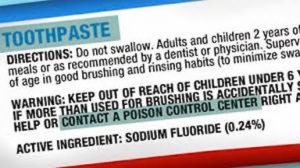Conventional Toothpastes Contain Harsh Chemicals, Make Your Own Tooth Powder
Last updated on
Keeping a clean mouth isn’t just important for pleasant-smelling breath but also increases your chance of maintaining overall good health. Many studies have linked oral health to a variety of diseases and conditions, some of which include endocarditis (infection of the inner lining of the heart), cardiovascular disease, pregnancy and birth complications, diabetes, osteoporosis and even Alzheimer’s.
Our mouths are full of different types of bacteria, most of them harmless; however, if not properly maintained, these bacteria can grow out of control, contributing to some pretty serious illnesses.
Practicing proper oral hygiene isn’t that difficult; it simply requires dedication, a good routine and an even better toothpaste or powder.
What’s In Your Conventional Toothpaste?

In addition to artificial sweeteners, traditional toothpastes contain harsh chemicals, preservatives and fluoride, which is continuously being unveiled as toxic and detrimental to our health.
Below are a few chemicals commonly found in conventional toothpaste:
Triclosan: Incorporated into many consumer products for 30+ years, this antimicrobial agent has been banned in several states, as it’s been linked to immune system degeneration and interfering with hormones.
Methlyparaben: Used as a preservative, this chemical is quickly absorbed by the skin and can act as a hormone mimicker, disrupting the endocrine system.
Propylene glycol: Linked to non-reproductive organ toxicity, this liquid alcohol is also used in antifreeze. It’s listed as a suspected neurotoxicant, respiratory toxicant and immunotoxicant.
Sodium lauryl sulphate, sodium laureth sulphate (SLS): Also used as a pesticide and herbicide, this chemical is a known skin and eye irritant. When heated, it releases toxic fumes and becomes volatile in heat released from mouth tissues.
Butylated hydroxytuolene (BHT): Used to mask taste and smell of other undesirable agents, according to its Materials Safety Data Sheet, if ingested, may cause abdominal pain, confusion dizziness, nausea and vomiting. It’s also combustible and extremely harmful to the environment.
As demonstrated, conventional toothpastes contain some pretty nasty stuff. But don’t fret, because making your own toothpowder is super easy and pretty inexpensive, especially with these tips from gnowfglins.com.
Create Your Own Toothpowder
Before making your own toothpowder, you must choose from the following for your base ingredients:
You can choose one, two or all three.
Baking soda helps whiten teeth and remove plaque, while bentonite clay cleanses, polishes and is full of minerals; it also makes an excellent face mask when combined with apple cider vinegar.
The following additions are optional:
- Finely ground sea salt (whitens and is antibacterial)
- Spirulina (add ¼ teaspoon)
- Finely ground sage, peppermint, cloves and cinnamon (for flavor)
- Neem (a large evergreen tree that’s been used medicinally for centuries due to its cleansing and antibacterial properties)
After choosing your base and optional add-ons, the rest is easy. Simply mix your ingredients together and store in a glass container with a shaker lid. Spice jars work perfectly for this. Another great thing about toothpowders is that, because there are no wet ingredients, they don’t expire.
Make your own natural, fluoride-free toothpaste.
Provided by gnowfglins.com, the recipes below are considered favorites:
- 1 tablespoon Natural Calm magnesium powder
- 1 tablespoon baking soda
- 1 teaspoon sea salt
- 1 teaspoon neem
- 1 teaspoon peppermint
- ¼ teaspoon spirulina
Another one:
- 1½ tablespoons clay
- ½ tablespoon baking soda
- 1 teaspoon sea salt
- 1 teaspoon sage
- 1 teaspoon peppermint
This article was originally published by NaturalNews.com. It is republished here with permission.
Sources:
https://gnowfglins.com/2015/01/19/homemade-herbal-tooth-powder-and-toothpaste/
https://www.toxipedia.org/display/toxipedia/Propylene+Glycol
https://fluoridealert.org/issues/dental-products/toothpastes/
https://paleoleap.com/brush-your-teeth-the-paleo-way/
https://www.cnn.com/2014/05/21/health/triclosan-ban-antibacterial/
https://www.ada.org/en/science-research/ada-seal-of-acceptance/product-category-information/toothpaste
https://www.mayoclinic.org/healthy-lifestyle/adult-health/expert-answers/triclosan/faq-20057861
https://www.ewg.org/skindeep/ingredient/703937/METHYLPARABEN/
https://www.ewg.org/skindeep/ingredient/706089/SODIUM_LAURETH_SULFATE/
https://www.sciencelab.com/msds.php?msdsId=9923084
Some of the links I post on this site are affiliate links. If you go through them to make a purchase, I will earn a small commission (at no additional cost to you). However, note that I’m recommending these products because of their quality and that I have good experience using them, not because of the commission to be made.


































 JOIN OVER
JOIN OVER
Comments